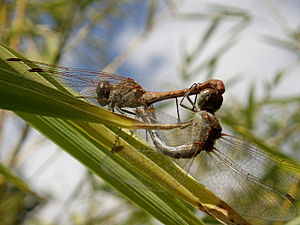Southern darter
| Southern darter | ||||||||||||
|---|---|---|---|---|---|---|---|---|---|---|---|---|

Southern darter ( Sympetrum meridionale ) |
||||||||||||
| Systematics | ||||||||||||
|
||||||||||||
| Scientific name | ||||||||||||
| Sympetrum meridionale | ||||||||||||
| ( Selys , 1841) |
The southern darter ( Sympetrum meridionale ) is a type of dragonfly from the family of the sail dragonflies (Libellulidae). These are a family of the dragonflies (Anisoptera).
features
The males of the southern darter are brown with a dash of light red and have only very small black triangles on the eighth and ninth segments . The length of the abdomen is between 24 and 25 millimeters. The wings are transparent and the pterostigma is dark gray in young animals, but turns light red with a black border with age. The legs are in a light reddish brown shade on the outside, but black on the inside. The dark seam lines on the chest that are found in other representatives of the genus are almost completely missing.
Similar species
The animal can be confused with other species of the genus such as the great darter , but differs from this by the lack of stripes on the thorax . Since single specimens of the southern darter often mix with the countless individuals of other darter species, they usually "disappear" in the crowd and are therefore difficult to identify.
Flight time
The dragonfly can be observed in Germany from July to September. In the Mediterranean, however, also from May and into October.
Habitat
The larvae prefer waters with stagnant water or with only low flow velocities as their habitat . In general, the waters populated by the species are usually relatively small and often astatic . Shallow water areas with changing water levels and temporary drying out are essential for settlement. When colonizing larger bodies of water, the larvae usually retreat to bays or shallow marginal areas in order to use the warm areas of the body of water for rapid development. The hatching usually takes place at a height of about ten to 50 centimeters. Adults prefer sunny spots under two meters in height near water. For hunting and growing up, however, the animals certainly also move away from their slip waters.
distribution
The southern darter is originally found only in the Mediterranean region . In recent years, however, the species has also been increasingly found in Central Europe, and in 2007 the records increased, especially in southern Germany. In Germany , the species is usually only viewed as a breeding guest, although in Baden-Württemberg and Bavaria it was down-to-earth for longer periods of time and will presumably establish itself permanently in the future. To the east it is found in Mongolia and southeastern Siberia .
Reproduction and development
The southern darter lays its eggs in tandem , as is usual with the darter . The eggs reach sizes between 0.4 and 0.5 millimeters. The typical clutch size is 500 eggs. After being laid, the eggs hibernate in diapause , which means that eggs in dry bodies of water or water areas can successfully produce larvae in spring when the water is renewed. The larval stage lasts approximately 22 days and it is not known how many stages it goes through. The lifespan is relatively short in the core of the distribution area in central Italy . Males are only 15.5 days old on average and females only 4.9 days old. However, the development time increases towards the south, so that individuals in Africa need up to three months for this.
Naming
The southern darter was first described as Libelulla meridionale by Selys in 1841 using a specimen from Sardinia . Meridonale is an adjective formed from the Latin word meridies , which means south. The next description was made in 1842 by Rambur , who described a male from Corsica as Libellula hybrida .
Individual evidence
- ^ A b Henrik Steinmann - World Catalog of Odonata (Volume II Anisoptera) [p. 477f], de Gruyter, 1997, ISBN 3-11-014934-6
- ↑ Archived copy ( Memento of the original from September 28, 2007 in the Internet Archive ) Info: The archive link was inserted automatically and has not yet been checked. Please check the original and archive link according to the instructions and then remove this notice. visited on May 8, 2006
- ↑ a b c d e f Klaus Sternberg, Rainer Buchwald: Die Libellen Baden-Württemberg . Vol. 2. Large dragonflies. Eugen Ulmer, Stuttgart 1999, 2000. ISBN 3-8001-3514-0
- ↑ a b Lehmann, Arne: Libellen , publisher: German Youth Association for Nature Observation, ISBN 3-923376-15-4
- ↑ http://www.biologie.uni-ulm.de/bio3/public_html/S_mer.html visited on May 8, 2006
literature
- Heiko Bellmann: Observe dragonflies - determine , Naturbuch Verlag, Augsburg 1993, ISBN 3-894-40107-9
- Gerhard Jurzitza: The Kosmos-Dragonfly Guide , Franckh-Kosmos Verlags GmbH & Co., Stuttgart 2000, ISBN 3-440-08402-7